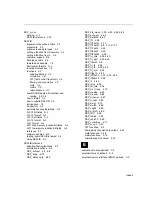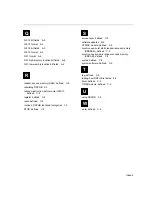
Glossary
C-9
Glossary
reset:
A means of bringing the CPU to a known state by setting the registers
and control bits to predetermined values and signaling execution to start
at a specified address.
RTOS
Real-time operating system.
S
service layer:
The top layer of the 2-layer chip support library architecture
providing high-level APIs into the CSL and BSL. The service layer is
where the actual APIs are defined and is the interface layer.
synchronous-burst static random-access memory (SBSRAM):
RAM
whose contents do not have to be refreshed periodically. Transfer of data
is at a fixed rate relative to the clock speed of the device, but the speed
is increased.
synchronous dynamic random-access memory (SDRAM):
RAM whose
contents are refreshed periodically so the data is not lost. Transfer of
data is at a fixed rate relative to the clock speed of the device.
syntax:
The grammatical and structural rules of a language. All higher-level
programming languages possess a formal syntax.
system software:
The blanketing term used to denote collectively the chip
support libraries and board support libraries.
T
tag:
The 18 most significant bits of the program address. This value
corresponds to the physical address of the fetch packet that is in that
frame.
timer:
A programmable peripheral used to generate pulses or to time
events.
TIMER module:
TIMER is an API module used for configuring the timer
registers.
W
word:
A multiple of eight bits that is operated upon as a unit. For the C6x,
a word is 32 bits in length.







































